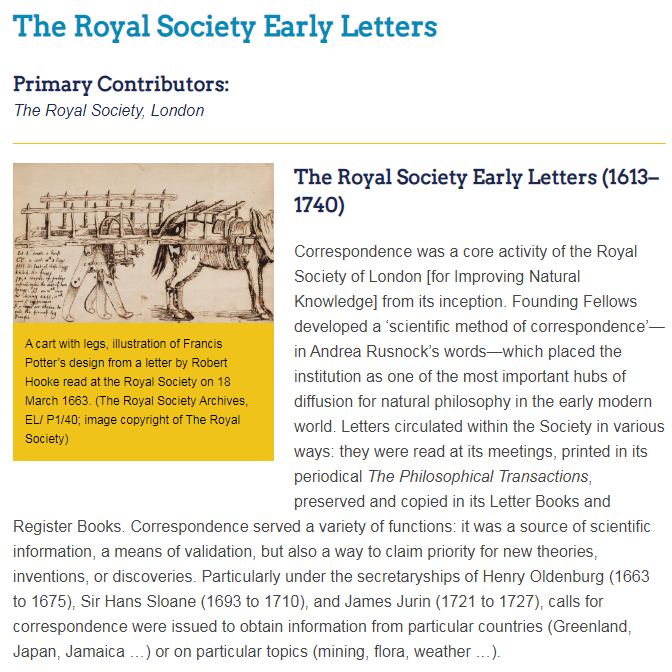It is a privilege to announce this week that a listing of the Royal Society’s collection of Early Letters has been released within Early Modern Letters Online [EMLO]. The catalogue contains at present (and this ‘at present’ will be explained further into the blog post for those who choose to read on) 4,109 letters drawn from a total of 4,390 manuscripts itemized in the Royal Society Library’s catalogue. The letters range between 1613 and 1740 (although three post-1740 letters have been identified) and, as a collection, they form an invaluable archive of the original incoming correspondence received at the Society by way of the institution’s secretaries, its office holders, and its early Fellows. Many of these letters were copied into the Society’s Letter Books and were referenced in the Register Books; many were published in the Philosophical Transactions. The letters encompass a remarkably diverse range of topics and scientific activities.
The suggestion to publish this inventory of the Early Letters in EMLO was initiated at a workshop entitled ‘Digital Approaches to the History of Science‘, an event organized last year by the AHRC-funded Reading Euclid project. Subsequently, metadata for the collection was prepared using EMLO’s many and various bespoke tools in partnership with the Royal Society Library, under the guidance of the Librarian, Keith Moore, and the Digital Resources Manager, Louisiane Ferlier. The first step involved removing the data that described a number of non-epistolary manuscripts; secondly, disambiguation (the ‘which Thomas Smith is which‘ process) and reconciliation for the associated people and the places were carried out (although a few queries remain still to be resolved); thirdly, the texts of the abstracts underwent an editorial ‘tidying’; and, fourthly, links were inserted into EMLO records at every turn—whether for a letter or for an early Fellow—to guide users to a range of the Royal Society’s rich resources available online.
Further updates to the listing of letters (and this where the ‘at present’ mentioned above comes in) include identifying and clustering within one EMLO record manifestations that the Library catalogue itemizes as separate records (for example, different manuscript versions of the same letter, or translations of the letter in different languages). This work will mean the total number of records in the early letters catalogue will decrease overall in EMLO. Thereafter, the numbers will swell once again as bundles of letters batched together hitherto in the Library’s catalogue (for example, three letters from Person A concerning Topic 1) are identified, separated out, and described individually. In consequence, EMLO will display a slightly different inventory to that maintained at the Library, but each EMLO manifestation will link to its relevant entry in the Society’s catalogue. And, in addition, details from other Royal Society Library sources will be recorded—whether entry in the Letter Books or publication in the Philosophical Transactions, as well as details of the date a letter was read to the Society. What is exciting about this element of the forthcoming work is that, combined with the way the manifestations will be ordered in EMLO and based upon how many versions exist and how many entries reference the letter, it will be possible to rank and determine at a glance the importance of individual letters to the early Society. Over the course of the next six months, updates to the Early Letters catalogue in EMLO will be released, as will further new catalogues of correspondence for a number of key early Fellows (and officer holders) of the Royal Society, including those of the Society’s president from 1703 to 1727 Isaac Newton … watch this space …

